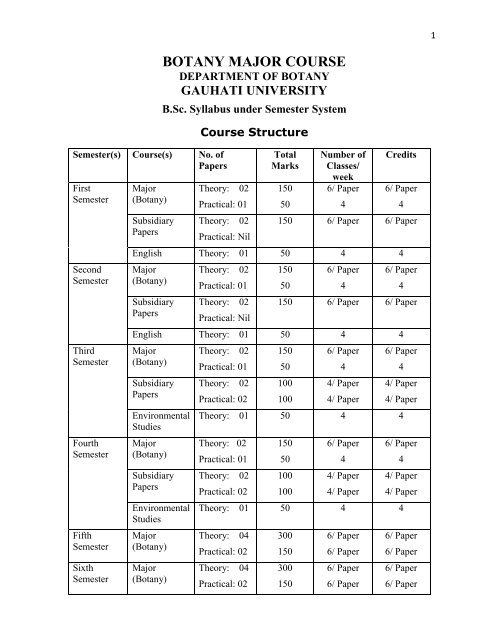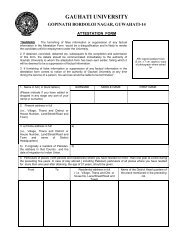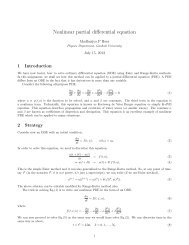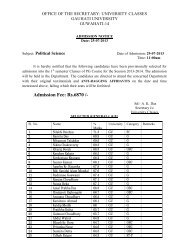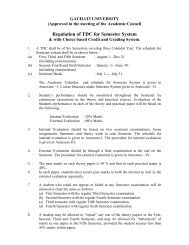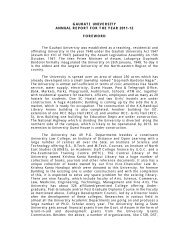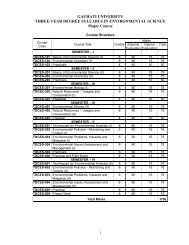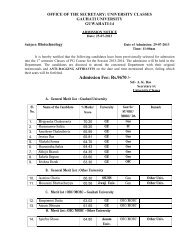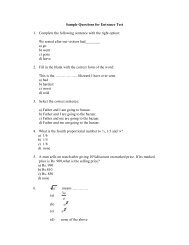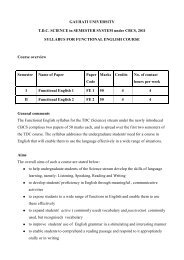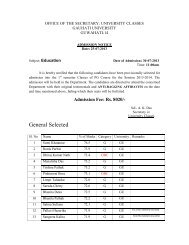Botany Major Syllabus(Semester) - Gauhati University
Botany Major Syllabus(Semester) - Gauhati University
Botany Major Syllabus(Semester) - Gauhati University
Create successful ePaper yourself
Turn your PDF publications into a flip-book with our unique Google optimized e-Paper software.
1<strong>Semester</strong>(s) Course(s) No. ofPapersFirst<strong>Semester</strong>Second<strong>Semester</strong>Third<strong>Semester</strong>Fourth<strong>Semester</strong>Fifth<strong>Semester</strong>Sixth<strong>Semester</strong><strong>Major</strong>(<strong>Botany</strong>)SubsidiaryPapersBOTANY MAJOR COURSEDEPARTMENT OF BOTANYGAUHATI UNIVERSITYB.Sc. <strong>Syllabus</strong> under <strong>Semester</strong> SystemCourse StructureTheory: 02Practical: 01Theory: 02Practical: NilTotalMarks15050Number ofClasses/week6/ Paper4Credits6/ Paper150 6/ Paper 6/ PaperEnglish Theory: 01 50 4 4<strong>Major</strong>(<strong>Botany</strong>)SubsidiaryPapersTheory: 02Practical: 01Theory: 02Practical: Nil150506/ Paper446/ Paper150 6/ Paper 6/ PaperEnglish Theory: 01 50 4 4<strong>Major</strong>(<strong>Botany</strong>)SubsidiaryPapersEnvironmentalStudies<strong>Major</strong>(<strong>Botany</strong>)SubsidiaryPapersEnvironmentalStudies<strong>Major</strong>(<strong>Botany</strong>)<strong>Major</strong>(<strong>Botany</strong>)Theory: 02Practical: 01Theory: 02Practical: 02150501001006/ Paper44/ Paper4/ Paper46/ Paper44/ Paper4/ PaperTheory: 01 50 4 4Theory: 02Practical: 01Theory: 02Practical: 02150501001006/ Paper44/ Paper4/ Paper6/ Paper44/ Paper4/ PaperTheory: 01 50 4 4Theory: 04Practical: 02Theory: 04Practical: 023001503001506/ Paper6/ Paper6/ Paper6/ Paper6/ Paper6/ Paper6/ Paper6/ Paper
2Summary of the Course StructureSl.No.Courses01 <strong>Major</strong> (<strong>Botany</strong>)Total no. ofpapersTotalMarksTotalClasses/weekTotalCredits1 st +2 nd +3 rd +4 th +5 th +6 th Practical:08 500 48 48Theory: 16 1200 96 96<strong>Semester</strong> (s):Theory: 08 500 32 3202 Subsidiary Papers1 st +2 nd +3 rd<strong>Semester</strong> (s): Practical:04 200 16 1603 English Papers: 02 100 08 0804 EnvironmentalStudiesPapers: 02 100 08 0805 Total <strong>Major</strong> 24 1700 144 14406 GrandTotalSubs 12 700 48 48Eng 02 100 08 08Env. Sc. 02 100 08 08Total No. ofCourses:0440 2600 208 208
3FIRST SEMESTERAllotment of Marks and CreditsPaper(s)Course work Internal Assessment Total Credit Class/weekM 101 (Theory) 60 15 75 6 6M 102 (Theory) 60 15 75 6 6M 103 (Practical) 40 10 50 4 4Total 160 40 200 16 16Examination Time:Theory …….…3 (Three Hours)Practical………4 (Four Hours)Course ContentPaper: M 101 (Theory)(Plant Kingdom, Algae and Fungi)A. Plant Kingdom: 10UNIT I: Classification of plant kingdom and criteria, diversity, form, life span, nutritionand ecological statusB. Algae: 30UNIT II: General characteristics, classification, morphology, reproduction, phylogeny andeconomic importance of AlgaeUNIT III: Life history of Chlorophyceae (Volvox, Coleochaete, Chara), Xanthophyceae(Vaucheria), Cyanophyceae (Anabaena, Nostoc)UNIT IV: Bacillariophyceae (General account), Phaeophyceae (Ectocarpus, Fucus),Rhodophyceae (Polysiphonia)C. Fungi: 20UNIT V: General characters, cell structure, nutrition, reproduction and sexuality; Economicimportance of FungiUNIT VI: Classification, phylogeny and life history of main classes of fungi with specialreference to the types as mentioned; Phycomycetes (Phytophthora, Mucor);Ascomycetes (Saccharomyces, Penicillium); Basidiomycetes (Puccinia,Agaricus); Deuteromycetes (Cercospora, Colletotrichum)
4Course ContentPaper: M 102 (Theory)(Bryophytes and Pteridophytes)Bryophytes: 30UNIT I:Classification and general account of structure, morphology, anatomy andPhylogenetic relationship among Hepaticopsida with reference to Riccia andMarchantia.UNIT II: Classification and general account of structure, morphology, anatomy andPhylogenetic relationship among Anthocerotopsida with reference to Anthoceros.UNIT III: Classification and general account of structure, morphology, anatomy andPhylogenetic relationship among Bryopsida with reference to Sphagnum andPolytrichum. Economic importance of BryophytesPteridophytes: 30UNIT IV: Classification, comparative study of morphology, anatomy, reproduction, stellardiversity, heterospory and seed habit with reference to Psilopsida (Psilotum).UNIT V: Classification, comparative study of morphology, anatomy, reproduction, stellardiversity, heterospory and seed habit with reference to Lycopsida (Lycopodium,Selaginella).UNIT VI: Classification, comparative account of morphology, anatomy, reproduction,stellar diversity, heterospory and seed habit with reference to Sphenopsida(Equisetum) and Pteropsida (Adiantum and Marsilea)Course ContentPaper: M 103 (Practical)(Division of marks: Algae-6, Fungi-6, Bryophytes-6, Pteridophytes-6, Techniques-2,Field records etc. 8 & Viva-voce -6=40)Study of eukaryotic organisms (Algae and Fungi) through permanent preparation (mountingand staining)I. Study of morphology and reproductive structures of the following types:1) Algae: Volvox, Chara, Ectocarpus, Fucus, Polysiphonia, Anabaena2) Fungi: Phytophthora, Mucor, Penicillium, Puccinia, Agaricus, Colletotrichum3) Bryophytes: Riccia, Marchantia, Anthoceros, Polytrichum, Sphagnum4) Pteridophytes: Lycopodium, Selaginella, Equisetum, Adiantum, MarsileaII. Techniques of permanent preparation of types studied (slides) and herbariumIII: Field studies, submission of field reports and collectionsIV. Viva-voce
5SECOND SEMESTERAllotment of Marks and CreditsPaper(s) Course work Internal Assessment Total Credit Class/ weekM 101 (Theory) 60 15 75 6 6M 102 (Theory) 60 15 75 6 6M 103 (Practical) 40 10 50 4 4Total 160 40 200 16 16Examination Time:Theory …….…3 (Three Hours)Practical………4 (Four Hours)Course ContentPaper: M 201 (Theory)(Gymnosperms, Paleobotany and Plant Anatomy)Gymnosperms:20 MarksUNIT I: Classification, evolutionary significance and salient features and significance ofgymnosperms.UNIT II: Comparative study of morphology, anatomy and reproduction of Cycadales(Cycas), Coniferales (Pinus, Cryptomeria, Thuja), Ginkgoales (Ginkgo) andGnetales (Gnetum)Paleobotany:20 MarksUNIT III: General account, anatomy and reproduction of Psilophyta (Rhynia),Lepidodendrales (Lepidodendron) and Sphenophyllaes (Sphenophyllum)UNIT IV: Process of fossilization. General account, anatomy and reproduction ofCycadofilicales (Lyginopteris), Bennettitales( Williamsonia) and Cordaitales(Cordaites)Plant anatomy:20 MarksUNIT V: Cell wall and cell membrane: Origin, ultra structure, chemical constituents andfunction of Cell wall and cell membrane, Models of cell membrane andorganizationUNIT VI: Tissues and their classification: Theories of structural development anddifferentiation of roots and shoots, different tissue systems and their functions,Anatomy of primary monocot and dicot roots, secondary growth of stems androots.
6Course ContentPaper: M 202 (Theory)(Cell Biology)UNIT I: Introduction to cell biology: Introduction to cell, membrane structure andfunction, membrane pump, membrane carrier, membrane channels, membranephysiologyUNIT II: Chromatin, chromosome and cell nucleus, Chemical and physical structure ofchromosome, Nuclear structure and dynamism, special types of chromosome andtheir significance.UNIT III: Cellular organelles and membrane trafficking, post translational targeting ofprotein, mitochondria, peroxisomes, endoplasmic reticulum, secretary membranesystem and golgi apparatus, endocytosis and endosomal membrane systemUNIT IV: Signaling mechanism, signal transduction and signal proteinUNIT V: Cell cycle: G phase and regulation of cell proliferation, S-phase, G2-phasemitosis and cytokinesis, meiosisUNIT VI: Structure and function of DNA and RNACourse ContentPaper: M 203 (Practical)(Division of marks: Gymnosperm-6, Paleobotany-6, Plant Anatomy-8, Cell Biology-6,Field records etc. 8 & Viva-voce -6=40)1. Gymnosperm: Cycas, Pinus, Cryptomeria, Gnetum, Thuja2. Paleobotany: Specimen and slides studies in theory paper3. Plant Anatomy: Study of gross anatomical details of cells, tissues and various otherorgans of plants4. Study of anomalous structure: Primary and secondary growth in stems covered undertheory syllabus5. Study of various stages of mitosis and meiosis using appropriate stain and plantmaterials
7THIRD SEMESTERAllotment of Marks and CreditsPaper(s) Course work Internal Assessment Total Credit Class/weekM 301 (Theory) 60 15 75 6 6M 302 (Theory) 60 15 75 6 6M 303 (Practical) 40 10 50 4 4Total 160 40 200 16 16Examination Time:Theory …….…3 (Three Hours)Practical………4 (Four Hours)Course ContentPaper: M 301 (Theory)(Ecology, Plant Geography, Evolution)Ecology: Marks: 40UNIT I:Introduction, Ecosystem structure (abiotic and biotic components), Plantadaptations in response to water, temperature and light.UNIT II: Population ecology: Population characteristics; Ecotypes; Ecads. Communityecology: Community characteristics; Frequency; Density; Cover; IVI; Lifeforms, Biological spectrum and its significance.UNIT III: Ecosystem ecology: food chain, food web, ecological pyramids; Ecosystemfunction (Energy flow, Biochemical cycles), Ecosystem services, Ecosystemresilience; Ecological succession: Types and pattern.UNIT IV: Environmental pollution: Water pollution: Sources and kinds, impact of pollutionon aquatic ecosystem, eutrophication of water bodies; Air pollution: sources andkinds, impact on plants, acid rain; Soil pollution: Sources and kinds, impact onplants and ecosystems.Plant Geography: Marks: 10UNIT V: Phytogeographical regions of India; Factors regulating distribution of plants,endemism, isolation and speciation; Vegetation of India with special reference toNorth Eastern Regions; <strong>Major</strong> biomes of the world.Evolution: Marks: 10UNIT VI: Evidences, theories and mechanism of evolution; Origin of new species. Genepool; Genetic drift; Changes in gene frequencies in population
8Course ContentPaper: M 302 (Theory)(Instrumentation and Laboratory Techniques)Instrumentation: Marks: 30UNIT I:Microscopy: Working principles of Electron, Phase contrast and fluorescencemicroscopy; Image documentation: Camera lucida- principle, types;microphotography, digital imaging-advantages of digital camera and digitization.UNIT II: Types and techniques of micro technique, Principles and applications of hot airoven, incubators, autoclave, laminar air flow chamber, centrifuge, lux meter, pHmeterUNIT III: Chromatography: Introduction, definition, concept of partition coefficient, Paperchromatography- principle, method, advantages; TLC and columnchromatography: principle, method, advantages and disadvantages;Spectroscopy: principle, Beer and Lambert’s law, mechanics of measurement;Spectrophotometer- working principle and applications.Laboratory Techniques: Marks: 30UNIT IV: Fixatives and stains: principles, types, procedures and applications; Methods ofsterilization and culture media; Mounting mediaUNIT V: Field and herbarium techniques, preservation of museum and herbariumspecimens, preservation techniques for special types of plants (submergedaquatic plants, succulent and xerophytes, palm, canes and bamboos)UNIT VI: Preparation of normal, molal, molar, ppm and percent solutions; Somogyi’sreagent, Biuret reagent, Nessler’s reagent, different indicatorsCourse ContentPaper: M 303 (Practical)Ecology, Laboratory Instrumentation and Laboratory techniques(Division of marks: Ecology-14, Instrumentation-6, Laboratory Techniques-6, Fieldrecords etc. 8 & Viva-voce -6=40)Ecology:1. Determination of abundance and frequency of species by quadrate method.2. To measure the dissolved oxygen content in polluted and unpolluted watersamples.3. Study of anatomical peculiarities with reference to ecological adaptations(xerophytes and hydrophytes; at least 3 plant samples for each type)4. Soil testing for the presence of Phosphorus, Potassium, Nitrate.
9Instrumentation and Laboratory Techniques:1. Image documentation of suitable botanical microscopic preparation by usingcamera lucida.2. Microtomy- Preparation and processing of suitable material up to blockpreparation, Sectioning, staining and mounting and permanent slidespreparation.3. Demonstrations- TLC chromatogram.4. Demonstration of different types of instruments as per theory syllabusmentioning their principles, functions and uses.5. Preparation of different stains, solutions and reagents as per theory paper.6. Submission of field report, permanent slides and practical records.
10FOURTH SEMESTERAllotment of Marks and CreditsPaper (s)Course work Internal Assessment Total Credits Classes/ weekM 401 (Theory) 60 15 75 6 6M 402 (Theory) 60 15 75 6 6M 403 (Practical) 40 10 50 4 4Total 160 40 200 16 16Examination Time:Theory …….…3 (Three Hours)Practical………4 (Four Hours)Course ContentPaper: M 401 (Theory)(Morphology, Palynology, Embryology of Angiosperms)Morphology: Marks: 20UNIT I: Origin and evolution of Angiosperms; Inflorescence and flowers. Morphology ofstamens and carpelUNIT II: Telome theory, Phyllode theory, Carpel polymorphism, Inferior ovary. Role ofmorphology in plant classification.Palynology: Marks: 10UNIT III: Aspects and prospects of Palynology, historical perspective, pollen morphology,methods of studying pollen, pollen production and sterilityEmbryology of Angiosperms: Marks: 30UNIT IV: Basics of embryology, microsporogenesis and megasporogenesis, developmentof male and female gametophytes, Types of embryosacs and evolutionarysignificanceUNIT V: Fertilization, embryo development, polyembryony, apomixes, endospermdevelopment, types, hautorial structure, experimental embryology: role in cropimprovement
11UNIT I:UNIT II:UNIT III:Course ContentPaper: M 402 (Theory)(Plant Taxonomy)Objectives, Principles and Evolutionary Trends in Taxonomy,History of plant classification; Concept of species, genus and family, Conceptof classificatory systems i.e. Artificial, natural, Phylogenetic, phenetic,cladistic, and APG; Detail study of Bentham and Hooker, and Takhtajan systemof classifications.Principles and rules of binomial nomenclature; ICBN- Historical developments,rules and recommendations; rules of priority and its limitations, type conceptsand its applications; concept of biocodeUNIT IV: Modern Trend in Plant Taxonomy and classification; Role ofanatomy,embryology, palynology in plant classification, Numerical Taxonomy,Chemotaxonomy, Cytotaxonomy, and SerotaxonomyUNIT V:UNIT VI:Affinities, phylogeny, economic importance and comparative studies of thefollowing families: Magnoliaceae, Ranunculaceae, Fabaceae, Mimosaceae,Caesalpinaceae, Malvaceae, Apiaceae, Euphorbiaceae, Solanaceae,Verbenaceae, Lamiaceae, Acanthaceae, Rubiaceae, Cucurbitaceae, Asteraceae.Affinities, phylogeny, economic importance and comparative studies of thefollowing families: Arecaceae, Poaceae, Musaceae, Zingiberaceae, Liliaceae,OrchidaceaeCourse ContentPaper: M 403 (Practical)(Morphology, Palynology, Embryology, Plant Taxonomy)(Division of marks: Morphology-5, Palynology-5, Embyology-5, Plant Taxonomy-11,Field records etc. 8 & Viva-voce -6=40)Morphology:1. Study of special types of inflorescences – Cyathium, Hypanthodium,Verticillaster, Hypanthium2. Study of special types of Fruits – Spurious fruits (Dillenia); Aggregate fruits(Custard apple, Michelia, Periwinkles, Polyalthia); Multiple fruits (Pine apple,Jack fruit).Palynology:1. Study the morphological nature of pollen grains by permanent preparation ofpollen slides from the plant materials available in the locality.
12Embryology:Study from permanent preparation of slides1. T.S. of young Anther; T.S. of mature Anther.2. Male gametophyte3. L.S. of different types of Ovules.4. L.S. of ovule showing different nuclear stages of embryo sac.5. L.S. of ovule showing types of Endosperm6. L.S. of Embryo – Dicotyledonous, MonocotyledonousPlant Taxonomy:Field trips:1. Description of specimen from members of locally available Dicotyledonous andMonocotyledonous families included in the theory.2. Description of specimens with preparation of keys up to generic level of locallyavailable plants.3. Submission of at least 20 numbers of herbarium of plant materials as per theorysyllabus and palynology slides.1. Study of vegetation, local and different localities in the country throughAcademic excursions.
13FIFTH SEMESTERAllotment of Marks and CreditPaper Course work Internal Assessment Total Credit Class /weekM 501 (Theory) 60 15 75 6 6M 502 (Theory) 60 15 75 6 6M 503(Theory) 60 15 75 6 6M 504 (Theory) 60 15 75 6 6M 505 (Practical) 60 15 75 6 6M 506 (Practical) 60 15 75 6 6Total 360 90 450 36 36Examination Time:Theory …….…3 (Three Hours)Practical………4 (Four Hours)Course ContentPaper: M 501 (Theory)(Microbiology and Immunology)UNIT I:UNIT II:UNIT III:UNIT IV:UNIT V:UNIT VI:General Microbiology: History and development, scope of Microbiology,introduction to microbial world, microbial taxonomy and its modern trendsMicrobial nutrition, growth and metabolism, microbiology of soil, air andwater, role of microorganisms in biogeochemical cycles (N, C, S cycles) innature, biological nitrogen fixationDistinguishing features of Actinomycetes, Archaebacteria and MycoplasmaGeneral account; Classification of Bacteria, Modern concept of Bacterial cell,Reproduction and Growth of Bacteria- genetic recombination; General accountof Rickettsiae, Chlamydeae and diseases caused by themGeneral characteristics; Classification of viruses, Nature of Viruses, Viroids,Virusoides, Prions, Replication of viruses – Lytic Cycle and Lysogenic Cycle(Bacteriophage), Transmission of virusesConcept of immunology, types of immunity, cell mediated and humoralimmunity, primary and secondary immune responses, antigen and antibodystructureand classes
14Course ContentPaper: M 502(Theory)(Plant Pathology and Lichen)Plant Pathology: Marks: 50UNIT I:General account and historical development; Common symptoms of plantdisease; Types of plant diseases according to major causal agents; Diseaseresistance; Physiology of parasitism; Host-parasite interaction.UNIT II: Concept of disease cycle, mechanism of disease development, dissemination andtransmission of plant pathogens, Epidemiology and Disease forecastingUNIT III: Defense mechanism: concept and definition; structural, chemical andbiochemical mechanismsUNIT IV: Study of following diseases with reference to causal organisms, symptoms,disease cycle and control measures:Late blight of potato, Rust of wheat, Grey blight of tea, White rust of crucifers,Powdery mildew of pea, Leaf spot disease of cabbage, Citrus canker, Yellowmosaic of bhindi, , papaya and Tobacco mosaic virus (TMV) diseaseUNIT V: Plant disease management- chemical control, biological control and developmentof transgenic for controlling plant diseasesLichen: Marks: 10UNIT VI: Lichens: General account, classification, structure and reproductionCourse ContentPaper: M 503 (Theory)(Cytogenetics, Plant Breeding and Biometrics)Cytogenetics: Marks: 30UNIT I:Principles of inheritance- Mendel’s Laws, deviations to Mendel’s law-Incomplete dominance, Co-dominance, Quantitative and polymeric geneinteraction, sex linked inheritance, Non-mendelian inheritance, extrachromosomal inheritanceUNIT II: Structural and numerical changes of chromosome: Structural changes-Chromosomal aberrations and evolutionary significance; Numerical changes-Euploidy (Polyploidy) and evolutionary significanceUNIT III: Linkage and crossing over, recombination and cytological basis of crossing over,linkage map
Plant Breeding: Marks: 20UNIT IV: Principles of plant breeding-Introduction, selection, hybridization and back crossmethodUNIT V: Heterosis and inbreeding depression- genetic basis; male sterilityBiometrics: Marks: 10UNIT VI: Mean, mode, median, standard deviation, t-test, chi-square test, measurement ofgene frequency, Hardy-Weinberg equilibrium15Course ContentPaper: M 504 (Theory)(Applied <strong>Botany</strong>)UNIT I:Algae as food, feed, medicine and commercial products, role of algae in soilfertilityUNIT II: Fungi- Role of fungi in agriculture, fungi as food, medicine and commercialproducts (Antibiotics, alcohols), mycotoxins and mycotoxicosis, Lichens asindicator plants, mycorrhiza and its role in plant development, Allergy andallergensUNIT III: Bacteria- useful and harmful effects, role of bacteria in agriculture, medicine,bioremediation, serologyUNIT IV: Breeding for disease resistance, induced mutation and crop improvement,induction of polyploidy and crop evolutionUNIT V: Deforestation and its effect on environment, impact of climate changeUNIT VI: Application of plant growth regulators in agriculture, methods of plantpropagation-grafting, layering and budding; bonsai, indoor gardeningCourse ContentPaper: M 505 (Practical)(Microbiology, Plant Pathology and Lichen)(Division of marks: Microbiology-25, Plant Pathology-15, Lichens-4, Field records etc.8 & Viva-voce -8=60)Microbiology:1. Gram staining of Bacteria2. Preparation, Sterilization of culture media: Basic liquid media (Broth) forcultivation of bacteria; Basic solid media for routine cultivation of fungi.3. Isolation of soil microorganisms by the serial dilution and agar plating method.
164. Isolation of microorganisms from air.5. Isolation of fungal pathogens from diseased plant parts.6. Pure culture technique: Streak-plate methods; Pour-plate method.7. Counting of bacterial cells using haemocytometerPlant pathology:Lichen:1. Isolation and culture of plant pathogen and establishment of Koch’s postulatesand their pathogenicity.2. Study of plant diseases like Late blight of potato; Black rust of Justicia andwheat; Leaf spot disease of cabbage; Grey blight disease of tea; Citrus canker;Yellow mosaic disease of papaya and bhindi; Tobacco mosaic virus representingFungal, Bacterial and Viral diseases studying their symptoms and by makingpermanent slides where ever possible.3. Collection, identification and preparation of field notes on diseased specimen ofany locality (at least 10 numbers).1. Study the thallus morphology of Foliose; Crustose; Fruticose Lichens.Course ContentPaper: M 506 (Practical)(Cytogenetics, Plant Breeding, Biometrics and Applied <strong>Botany</strong>)(Division of marks: Cytogenetics-15, Plant Breeding-15, Applied <strong>Botany</strong>-12, Fieldrecords etc. 10 & Viva-voce -8=60)1. Karyotype study in onion, garlic and Aloe vera2. Study of chromosomal aberration in Tradescantia / Rhoeo3. Study of gene interaction4. Study of emasculation process in any plant5. To work out mean, mode, standard deviation and standard error6. Isolation of Rhizobium from root nodules7. Counting of pollen grains in honey samples8. Submission of permanent slides (at least 5 numbers)9. Submission of practical notebooks and collected specimens showing applied aspects
17SIXTH SEMESTERAllotment of Marks and CreditPaperCourse work Internal Assessment Total Credits Class /weekM 601 (Theory) 60 15 75 6 6M 602 (Theory) 60 15 75 6 6M 603(Theory) 60 15 75 6 6M 604 (Theory) 60 15 75 6 6M 605 (Practical) 60 15 75 6 6M 606 (Practical) 60 15 75 6 6Total 360 90 450 36 36Examination Time:Theory …….…3 (Three Hours)Practical………4 (Four Hours)Course ContentPaper: M 601 (Theory)(Molecular Biology and Plant Biochemistry)Molecular Biology:30 MarksUNIT I:UNIT II:Structure and organization of gene, expression and regulation of gene (Lacoperon concept), Genetic code; properties and evidencesDNA replication, different forms of RNA and their roles, concept of exons andintrons, Transcription and Translation in ProkayotesUNIT III: Mutation: Point mutation-transition, transversion, frameshift mutation,molecular mechanism (tautomerization, alkylation, deamination, baseanalogues, dimerization)Plant Biochemistry:UNIT IV:UNIT V:UNIT VI:30 MarksNitrogen metabolism, Amino acid metabolism and protein synthesisEnzymes- Classification and nomenclature of enzymes, Enzyme as biocatalyst,properties and functionCarbohydrate metabolism - Structure of monosaccharides, disaccharides andpolysaccharides
18Course ContentPaper: M 602 (Theory)(Bioinformatics, Computer Application and Biotechnology)Bioinformatics: Marks: 20UNIT I:Introduction to Bioinformatics, branches of Bioinformatics, Aim, Scope andResearch areas of Bioinformatics, biological databases, classification format ofdatabases, biological database retrieval systemUNIT II: Application of Bioinformatics: Basics of Molecular phylogeny, drug discoveryand drug design, DNA data bank, genomics, proteomics and their application incrop improvementComputer Applications: Marks: 10UNIT III: Basics of computer, use of operating system (MS Office), Data representation,Internet browsing and searching of biological data using search enginesBiotechnology Marks: 30UNIT IV: History, scope and significance of biotechnologyUNIT V: Plant Tissue culture-different techniques, micropropagation, meristem culture,embryo culture, somatic embryogenesis, pollen culture and development ofhaploid plants, somaclonal variation, transgenic plantsUNIT VI: Plant genetic engineering, techniques and applications: (restriction enzymes,construction of DNA libraries, DNA fingerprinting, DNA sequencing),application in agriculture and medicinesCourse ContentPaper: M 603 (Theory)(Plant Physiology)UNIT I:UNIT II:Plant-soil-water relationship: component and classification of soil, Soil to plantwaterpotential, osmotic potential, Movement of water within the plant body:absorption, transpiration and its significance, factors, mechanisms oftranspiration, ascent of sapMineral nutrition and mineral salt absorption, criteria of essentiality ofelements, micro and macro nutrients- specific functions and deficiencysymptoms, mineral salt absorption
UNIT III: Photosynthesis: photolysis of water, cyclic and non-cyclicphotophosphorylation, electron transport system, C3 cycle, photorespirationand glycolytic metabolism (C2 cycle), CAM pathway, C4 cycle,chemosynthesis19UNIT IV:UNIT V:UNIT VI:Respiration: Aerobic respiration, Glycolysis (EMP, PPP) and TCA cycles andits regulation, anaerobic respiration mechanism and factorsTranslocation of organic solutes: mechanism of translocation, diffusion, Munchhypothesis, source and sink relationships, phloem loading and unloadingGrowth and development: Phages of growth, growth regulation-physiologicalrole and mechanism of action (Auxins, cytokinins, GA, ABA, ethylene);Physiology of flowering - photoperiodism and vernalization; seed dormancytypesand causes, methods of overcoming dormancy; senescence and aging;stress physiology-concept of biotic, abiotic and xenobiotic stresses.Course ContentPaper: M 604 (Theory)(Plant Resource Utilization)UNIT I:Origin of Cultivated Plants: Concept of centers of origin; Plant introduction;Crop domestication; Classification of plant resources on the basis of their uses;Cereals: Rice, wheat and their role in green revolution; Leguminous plantresources: soybean, arhar dal, pea - their products and usesUNIT II: Beverages: Tea, Coffee and cocoa - their sources, products and uses; Spices andcondiments: Sources and uses of black pepper, cinnamon, clove, bay leaf,turmeric, zinger; Oil: Mustard, groundnut, castor and citronellaUNIT III: Fibers - <strong>Botany</strong> and uses of cotton, jute and ramie; Fruits - orange, pineapple,banana; Products and byproducts of sugar industry - Sugarcane, sugar beatUNIT IV: Timber and non-timber plant resources: sal, gamari, teetasopa; <strong>Botany</strong> and uses ofcane and bamboo, Para-rubber, herbal dye (henna, manjistha, bixa); <strong>Botany</strong> anduses of medicinal plants (Holarhhena, Rauvolfia, Catharanthus, Taxus,Plumbago, Azadirachta, Andrographis)UNIT V: Pharmacognosy: Pharmacognosy and its importance in medicinal plant usesUNIT VI: Ethnobotany- Definition, concept and scope; discipline and sub-disciplines ofethnobotany, importance of traditional knowledge in relation to plant uses andIPR (Intellectual Property Rights)
20Course ContentPaper: M 605 (Practical)(Molecular Biology, Biotechnology, Bioinformatics and Computer Application)(Division of marks: Molecular Biology-14, Biotechnology-10, Bioinformatics-10,Computer Application-10, Field records etc. 8 & Viva-voce -8 = 60)Molecular Biology:1. Prepare the standard curve of protein and determine protein content in plantmaterials by Biuret method.2. Separate and identify amino acids present in plant extract by (i) PaperChromatography, (ii) Thin Layer chromatography.3. Quantitative estimation of reducing sugar and total sugar by Somogyi’s method.4. Separate and identify chlorophyll pigments by Paper Chromatography.5. Determine Titratable Acid Number (TAN) in Bryophyllum leaves.6. Estimation of Total Nitrogen by Micro Kjeldahl method.Biotechnology:1. Preparation and sterilization of the medium, Slant preparation and Inoculation -MS medium.2. Micro propagation of some important plants.3. Study of Genetic engineering Techniques (photographs): FISH, DNAFingerprinting, DNA Sequencing, Gene gun, Ti plasmid.4. Study of steps of genetic engineering techniques from photographs (Bt cotton,Golden rice, Flavr Savr tomato)5. Construction of Restriction Map from the data provided.6. Aseptic seed germination - legume seed7. Study of different bio fertilizers.8. Homology Modeling through the BLAST (For Genes)Bioinformatics:1. Nucleic acid and protein databases.2. Sequence retrieval from databases.3. Sequence alignment.4. Sequence homology and Gene annotation.5. Construction of phylogenetic treeComputer Application: As per theory syllabus
Course ContentPaper: M 606 (Practical)(Plant Physiology and Plant Resource utilization)(Division of marks: Plant Physiology-25, Plant Resource Utilization-20, Field recordsetc. - 7 & Viva-voce -8=60)Plant Physiology:1. Determine the osmotic potential of cell sap by plasmolytic method.2. Determine the water potential of plant tissue.3. Determine the stomatal index, stomatal frequency and estimate the transpirationrate of different types of leaves.4. Study the effect of temperature on the rate of imbibitions and determine the Q 10 .5. Determine RQ of different plant materials (Seeds, Leaf buds, Flower buds).6. Extract and separate chloroplast pigments by solvent method and Paperchromatography7. Determine effect of CO 2 concentration on the rate of photosynthesis.Plant Resource Utilization:1. Chemical tests for tannins (Tea); Alkaloids (Vinca rosea)2. Pharmacognosical studies of both crude and powdered drugs - Zinger,Holarrhena, Rauwolfia3. Histochemical test for Curcuma longa, starch in non-lignified vessels(Zingiber); Alkaloid (Andrographis, Neem and Plumbago)21
22BOTANY GENERAL COURSEGAUHATI UNIVERSITYB.Sc. <strong>Syllabus</strong> under <strong>Semester</strong> SystemCourse Structure<strong>Semester</strong>(s) Course(s) No. of Papers Total No. of Credit (s)Marks Classes/w1 st <strong>Botany</strong>General01 (E101)Theory75 6 62 nd <strong>Botany</strong>General3 rd <strong>Botany</strong>General4 th <strong>Botany</strong>General5 th <strong>Botany</strong>General6 th <strong>Botany</strong>General01 (E201)Theory02E301-TheoryE302-Practical02E401-TheoryE402-Practical02E501-TheoryE502-Practical02E601-TheoryE602-Practical75 6 650+50(100)50+50(100)100+100(200)100+100(200)(4+4)8(4+4)8(8+8)16(8+8)16(4+4)8(4+4)8(8+8)16(8+8)Total Marks 750 60 6016
23FIRST SEMESTERAllotment of Marks and CreditsPaper(s) Course work Internal Assessment Total Credit Class/weekE 101 (Theory) 60 15 75 6 6Total 60 15 75 6 6Examination Time:Theory 3 (Three) HoursCOURSE CONTENTPaper: E 101(Theory)(Diversity of Microbes and Cryptogams)UNIT I:UNIT II:Introductory <strong>Botany</strong>: Classification of plant kingdom, Importance of plant forhuman life and support systemAlgae - General characters, classification, Life history and Economic importanceof Cyanophyceae (Anabaena), Chlorophyceae (Volvox, Oedogonium),Phaeophyceae (Ectocarpus), Rhodophyceae (Polysiphonia)UNIT III: Viruses, Bacteria, and Lichen - General account of viruses, Bacteriophages,Transmission of viruses; Classification of bacteria, Ultra structure of bacterialcell, reproduction and economic importance of bacteria; Lichen - GeneralAccount and economic importanceUNIT IV: Fungi and Plant Pathology- General Characters, cellular organizations, nutrition,reproduction, classification, and Economic importance; Life history ofPhycomycetes (Phytophthora, Mucor); Ascomycetes (Saccharomyces.Penicillium, Peziza); Basidiomycetes (Puccinia); Deuteromycetes(Helminthosporium); Plant disease symptoms, disease cycle and controlmeasuresUNIT V:Bryophytes - Morphology, structural organization, habit, reproduction,classification and life histories of the following: Hepaticopsida (Marchantia);Anthocerotopsida (Anthoceros) and Bryopsida (Funaria)UNIT VI: Pteridophytes - Origin and evolutionary trends, classification, morphological andanatomical characteristics and life cycles of the following: Lycopsida(Lycopodium, Selaginella); Sphenopsida (Equisetum); Pteropsida (Pteris)
24SECOND SEMESTERAllotment of Marks and CreditsPaper(s) Course work Internal Assessment Total Credit Class/weekE 201 (Theory) 60 15 75 6 6Total 60 15 75 6 6Examination Time: Theory 3 (Three) HoursCOURSE CONTENTPaper: E 201(Theory)(Cell Biology and Genetics)UNIT I:UNIT II:Structure of prokaryotic and eukaryotic cell, ultra structure of nucleus,mitochondria, and chloroplastChromosome organization - morphology of chromosome, types of chromosome;structure and function of DNA and RNA and their replicationsUNIT III: Cell division - Mitosis and meiosis and their significanceUNIT IV: Gene expressions - Structure of genes, protein synthesis, regulation of geneexpression in prokaryotic and eukaryotic cellUNIT V:Mendelian genetics - Laws of segregation and independent assortment, allelicand non-allelic interactions, incomplete dominanceUNIT VI: Linkage and crossing over and their significance; Changes in chromosomestructure and number and their role in evolution, mutations- spontaneous andinducedTHIRD SEMESTERAllotment of Marks and CreditsPaper Course work Internal Assessment Total Credit Class/weekE 301 (Theory) 40 10 50 4 4E 302 (Practical) 40 10 50 4 4Total 80 20 100 8 8Examination Time: Theory: 3 HoursPractical: 4 Hours
25Course ContentPaper: E 301 (Theory)(Diversity of Seed Plants and their Systematic)UNIT I:Gymnosperms: Introduction, general characters, classification, Origin &Evolution of seed habit.UNIT II: Morphology of vegetative and reproductive structures, anatomy of stem & leaf,and life cycle of the following types: Cycas, Pinus, GnetumUNIT III: Fossilization processes, General characteristics of Cycadofilicales, Bennettitales.UNIT IV: Taxonomy of angiosperms: Introduction, Scope and objectives, BinomialNomenclature, Taxanomic Ranks, General accounts of systems of classification– artificial, natural, phylogenetic. Salient features of classification systems withmerits and demerits of Bentham and Hooker; Engler and Prantl.UNIT V: Diversity of flowering Plants: Systematic position (Bentham & Hooker system)distribution, general characters, floral formula, floral diagram, distinguishingcharacters and economically important plants of the following families.1. Magnoliaceae, 2. Malvaceae, 3. Papilionaceae, 4. Caesalpinaceae, 5.Mimosaceae, 6. Apiaceae, 7. Euphorbiaceae, 8. Lamiaceae, 9. Solanaceae, 10.Verbenaceae, 11. Asteraceae, 12. Poaceae, 13. OrchidaceaeCourse ContentPaper: E 302 (Practical)(Diversity of Microbes and Cryptogams, Cell Biology and Genetics,Diversity of Seed Plants and their Systematics)(Division of Marks: Diversity of Microbes and Cryptogams: 10; Cell Biology andGenetics: 10; Diversity of Seed Plants and their Systematics:10; practical records etc. 5;Viva –voce:5)1. Study of vegetative, reproductive bodies of genera included under Algae, Fungi(inclusive of plant diseases) of theory syllabus.2. Study of morphology, anatomy and detailed reproductive structures of Bryophyta andPterydophyta genera included under theory syllabus.3. Gram staining of Bacteria.4. Examination of stages of Mitotic and Meiotic cell divisions.5. Gymnosperms: Study morphology and anatomy of leaf/stem, detailed reproductivestructures of Cycas, Pinus, Gnetum.6. Study of fossil specimens and slides.7. Angiosperms: Description of specimen from representative of locally available plantsbelongs to the families included in theory syllabus.8. Submission of Practical Note Books, Permanent slides.9. Field work report
26FOURTH SEMESTERAllotment of Marks and CreditsPaper Course work Internal Assessment Total Credit Class/ weekE 401 (Theory) 40 10 50 4 4E 402 (Practical) 40 10 50 4 4Total 80 20 100 8 8Examination Time: Theory: 3 HoursPractical: 4 HoursCourse ContentPaper: E 401 (Theory)(Plant Physiology and Biochemistry)UNIT I:UNIT II:UNIT III:UNIT IV:Plant water relations: Plant-water relations: Different bio-physio-Chemicalphenomenon: definition, phenomenon and Importance of permeability,diffusion, osmosis, Plasmolysis, imbibition, Absorption of water-Introduction,mechanism of water absorption (Active and passive theories), Ascent of sap:Definition, mechanism- (root pressure theory, capillarity, Imbibitional andtranspiration pull theories), Transpiration: Definition, types, structure ofstomata. Mechanism of opening and closing of stomata (Starch- sugar, K +(Potassium ion) pump theory)Mineral nutrition: Essential macro and micro elements and their role in plants(deficiency, symptoms, disease and functions), Translocation of organicsolutes: Introduction, direction of translocation, Mechanism: Mass flow ormunch hypothesis, protoplasmic streaming theoryPlant metabolism: Photosynthesis: introduction, Ultra structure of chloroplast,photosynthetic pigments, concepts of two Photo systems, Light phase: cyclicand non cyclic photophoshorylation (z- scheme), Dark phase: calvin cycle (C3)Hatch and Slack cycle (C4) and crassulacean acid metabolism, significance ofphotosynthesis, Respiration: Intorduction, Types of respiration - Aerobic:Glycolysis, TCA cycle ETS (Oxidative phosphorylation) respirationGrowth and Development: Growth and growth hormones: Phases of growth,factors affecting growth, Plant growth substances, hormones and their Practicalapplications; Seed dormancy: Introduction, methods of breaking SeedDormancy, factors affecting seed dormancy; Physiology of flowering:Photoperiodism (LD/SD/DN plants) Vernalization and Devernalization; Plantsmovements: Classification of movements, Movements of curvature.Movements of variation (paratonic –nastic)UNIT V: Biochemistry: Elementary biochemistry: Introduction, different organicconstituents of the cell, Functions of carbohydrates (mono /oligo /polysaccharides) starch, Cellulose, Hemicellulose, proteins and nucleic acids,
lipid, alkaloids, gums, mucilage and organic acids; Nitrogen metabolism:Introduction, physical and biological nitrogen fixation, nitrogen in soil,ammonification and nitrification, denitrification; Enzymes: Introduction,nomenclature and classification, mechanism and mode of action. Concept ofholoenzymes, apoenzymes, coenzymes and cofactors.27COURSE CONTENTPaper: E 402 (Practical)(Plant Physiology and Biochemistry)1. Determine the osmotic potential of cell sap by plasmolytic method.2. Determine the Diffusion Pressure Deficit (DPD) of plant cells.3. Determine the effect of time period on the rate of imbibition in different types ofseeds.4. Determine the relation between absorption and transpiration.5. Measure the effect of different environmental conditions on the rate oftranspiration of a twig by Ganong’s Potometer.6. Determine the effect of CO 2 concentration on the rate of photosynthesis.7. Determine RQ of different plant materials (Germinating seeds, Leaf buds, Flowerbuds).8. Qualitative analysis of plant materials to prove the presence of Sucrose, Glucose,Proteins, Fats and Cellulose.9. Qualitative analysis of Plant ash to prove the presence of Iron, Potassium,Calcium, Magnesium, Phosphorus.
28FIFTH SEMESTERAllotment of Marks and CreditsPaper Course work Internal Assessment Total Credits Class/weekE 501 (Theory) 80 20 100 8 8E 502 (Practical) 80 20 100 8 8Total 160 40 200 16 16Examination Time: Theory: 3 HoursPractical: 4 HoursCOURSE CONTENTPaper: E 501 (Theory)(Structure, Development and Reproduction in Flowering Plants)UNIT I:Basic body plan of flowering plant, modular type of growth, diversity in plantforms – annuals, biennials and perennials, Histological organization of root andshoot apices, various theories of cellular organizationUNIT II: Types of tissue: Meristematic tissue – meristem, structure and types based onorigin and position, Permanent tissue: Simple, Complex and Secretary,Epidermal tissue: Trichomes and Stomata.UNIT III: Anatomy: Primary structure of root, stem and leaf of Monocot and Dicot,Secondary growth in root and stem, Wood anatomy: Growth rings, heart woodand sap wood, Periderm: Origin, structure and functions, Floral biologyUNIT IV: Embryology: Microsporogenesis and development of male gametophyte,megasporogenesis and development of female gametophyte, Double fertilizationand its significance.UNIT V: Development of dicot embryo, Structure, development and types of endosperms,Fruit: Development and maturation of fruit, types and parts of fruits, fruitdispersal strategies, Vegetative propagation: Grafting, layering and budding.UNIT VI: Seed: Types of seed, germination of seeds-types and nature and dispersal ofseeds, factors affecting germination
29COURSE CONTENTPaper: E 502 (Practical)(Structure, Development and Reproduction in Flowering Plants)1. Study of non-living cell inclusion (ergastic maters): Starch grains, Aleuronegrains, Raphides, Cystolith.2. Study of types of stomata.3. Study of epidermal hairs.4. Study of secondary growth in thickness by permanent preparation of differentiallystained slide: Amaranthus, Boerhavia, Mirabilis, Bougainvillea, Dracaena,Tinospora.5. Study from permanent slide: T.S. through young and mature anther; Malegametophyte; L.S. of ovule showing different nuclear stages of embryo sac; L.S.of ovule showing types of Endosperm; L.S. of Embryo – Dicotyledonous,Monocotyledonous.6. Study of spurious fruits, aggregate fruits, composite fruits (at least 2 types each).7. Study the adaptation in fruits and seeds for dispersal through air (at least 4 types).8. Demonstrate the process of: Budding; Air layering; Scion grafting.9. Practical Records, Permanent slides to be submitted in the examination.
30SIXTH SEMESTERAllotment of Marks and CreditsPaper Course work Internal Assessment Total Credits Class/weekE 601 (Theory) 80 20 100 8 8E 602 (Practical) 80 20 100 8 8Total 160 40 200 16 16Examination Time: Theory: 3 HoursPractical: 4 HoursCOURSE CONTENTPaper: E 601 (Theory)(Ecology and Utilization of Plants)Ecology:UNIT I: Introduction, concept, definition, Autecology and Synecology, EcosystemEcology: Introduction, ecological organization – species population, communityecosystem and biosphere, Kinds of ecosystem, structure and function ofecosystem, abiotic components, biotic components and their role.UNIT II: Ecological succession-Types and pattern, food chain, food web, ecologicalpyramidUNIT III: Bio-geo-chemical cycles-concept, details of Nitrogen and carbon cycle,Composition and functioning of ecosystem: i) Simple – pond ecosystem,ii) Complex – forest ecosystem, iii) Artificial – crop land ecosystem.UNIT IV: Ecological grouping of plants with reference to their significance of adaptiveexternal and internal features: Hydrophytes and Xerophytes. Environmentalpollution with special reference to Air and Water pollutions - causes, effects andcontrol measures; Green house effect.Utilization of Plants:UNIT V: Classification of plants on the basis of Botanical sources and uses of Rice,Wheat, Maize,UNIT VI: Sugar cane, Gram, Pea, Coffee and Tea, Black pepper, Turmeric, Clove, andmustard - Their uses and botanical sourcesUNIT VII: Non timber plant products - Cotton, Jute, Rubber, Bamboo, and Jatropha.Their uses and botanical sourcesUNIT VIII: Timber and medicinal plant resources: Teak, Sal, Rauvolfia, Neem, Cinchonatheiruses and botanical sources
31COURSE CONTENTPaper: E 601 (Practical)(Ecology and Utilization of Plants)Ecology:1. Determine the frequency and density of herbaceous species by quadratemethod2. Study the anatomical features of some commonHydrophytes: Root of Eichhornia, Petiole of Eichhornia, stem of Hydrilla,Petiole of Nymphaea.Xerophytes: Leaf of Nerium, Leaf of Thevetia, Leaf of Grass.3. Test for the presence of inorganic salts in the soil: Chloride, Sulphate,Phosphate.Utilization of Plants:1. Study the morphology, parts used, chemical nature and uses of the following plantsa) Cereals – Rice.b) Pulses and legumes – Pea.c) Beverages – Tea.d) Fibres – Cotton, Jutee) Fats and oils –Mustard.f) Spices – Black pepper, Turmeric.g) Medicinal – Rauvolfia, Neem.h) Fuel – Jatropha.i) Sugar-Sugar cane
32BOTANY MAJORREFERENCESFIRST SEMESTERPAPER: M 101PLANT KINGDOMDutta A. C. : <strong>Botany</strong> for Degree StudentsALGAE1. Chapman, V.J. & D.J. Chapman : The Algae.2. Kumar, H.D, & H.N. Singh : A Text Book of Algae3. Pandey, B.B : A Text Book of <strong>Botany</strong> - Algae.4. Sharma. O.P : Text Book of Algae5. Singh, S.K. & S. Srivastava : A Text Book of Algae.6. Vashishta, B.R : <strong>Botany</strong> for degree students –Algae.FUNGI1. Alexopoulos, C.J : Introductory Mycology.2. Dube., H.C. : A Text Book of Fungi.3. Purohit, S.S. : Viruses, Bacteria and Mycoplasma.4. Sharma, O.P. : Text Book of Fungi.5. Singh, S.K. & S. Srivastava : A Text Book of Fungi.6. Srivastava, J.P. : An introduction of Fungi.7. Vashista, B.R. : <strong>Botany</strong> for Degree students. Part II. Fungi.PAPER: M 102BRYOPHYTES1. Chopra, R.N. : Bryophyta2. Gupta, S.K. : Introductory <strong>Botany</strong> Vol II - Bryophyta andGymnospems3. Parihar, N.S : An Introduction to Embryophyta.4. Puri, P. : Bryophytes.5. Rashid, A. : An Introduction to Bryophyta.6. Singh, S.K. : Text Book of Bryophyta.7. Vashishta, B.R. : <strong>Botany</strong> for degree student –Bryophyta.PTERIDOPHYTES1. Pandey, B.P. : A Text Book of Bryophyta, Pteridophytaand Gymnosperms2. Parihar, N.S. : An introduction to Embryology. Vol-II.Pteridophyta and Gymnosperms3. Rashid, A. : Pteridophyta.4. Singh, S.K. : Pteridophyta.5. Vashishta, P.C. : <strong>Botany</strong> for Degree Students, Vol IV –Vascular Cryptogams (Pteridophyta),
33SECOND SEMESTERPAPER: M 201GYMNOSPERMS1. Bhatnagar, S.P. & A. Moitra : Gymnosperms.2. Chamberlain, C.J : Gymnosperm, Structure and Evolution.3. Vasishta, P.C : Gymnosperm.PALAEOBOTANY1, Agashe, S.N. : Palaeobotany.2. Andrews, Jr.H.N. : Studies in Palaeobotany.3. Arnold, C.A : An Introduction to Paleobotany4. Meyen, S.V. : Fundamentals of Palaeobotany.5. Shukla.A.C. & S.P. Mistra : Essentials of Palaeobotany.6. Taylor, T.N. : Palaeobotany-An Introduction to Fossil `Plant BiologyPLANT ANAOTMY1. Eames, A.J. & Mac Daniels : An Introduction to Plant Anatomy.2. Esau, K. : Plant Anatomy.3. Fahn, A. : PLANT Anatomy.4. Pandey, B.P. : Plant Anatomy.5. Vashista, P.C. : A text Book of plant Anatomy.PAPER: M 202CELL BIOLOGY1. Berry, A.K. : A Text Book of Cell Biology2. Power, C.B. : Cell Biology.3. Rastogi, S.C. : Cell biology.4. Singh S.P & B.S. Tomar : Cell biology.5. Sundara Rajan, S. : Introduction Cell Biology.THIRD SEMESTERPAPER: M 301ECOLOLGY1. Odum, E.P. : Fundamentals of Ecology2. Odum, E.P. : Basic Ecology3. Sharma, P.D : Ecology and Environment.4. Shukla, R.S & I.P.S. Chandel : Plant Ecology and Soli Science.5. Shukla,R.S. & P.S. Chandel : A Text Book of Plant Ecology6. Samba Murty, S. : Ecology7. Vasishta, P.C. : Plant Ecology.8. Verma, V. A. : Text Book of plant Ecology.9. Weaver & Clements : Plant Ecology.EVOLUTION1. Strickberger : Evolution.
34PAPER: M 302BIOLOGICAL INSTRUMENTATION1. Bajpai, P.K. : Biological instrumentation & methodology.2. Rana, S.V.S. : Biotechniques – Theory and Practice.PLANT MICROTECHNIQUE1. Johansen, D.A. : Plant Microtechnique.2. KHASIM, J.K. : Botanical Microtechnique, Principles andPractice.3. Prasad and Prasad : Outlines of Botanical Micro technique.4. Sas. Joe E : Botanical Microtechnique.FOURTH SEMESTERPAPER: M 401MORPHOLOGY1. Eames, A.J. : Morphology of Angiosperms.2. Rao, A. : Morphology of Angiosperms.PALYNOLOGY1. Erdtman, G. : Pollen Morphology and Plant Taxonomy.2. Faegri, K. & J. Iverson : Text Book of Pollen Analysis.3. Nair, P.K.K. : Pollen Morphology of Angiosperms.4. Saxena, M.R. : Palynology – A treaties.5. Shivana & Johri : The Angiosperm Pollen.6. Shivana, K.R. & N.S. Rangaswami: Pollen Biology.EMBRYOLOGY OF ANGIOSPERMS1. Bhojwani, S.S & S.P. Bhatnagar : The Embryology of Angiosperms.2. Dwivedi, J. N. : Embryology of Angiosperms.3. Johri, B.D. : Embryology of Angiosperms.4. Maheshwari, P. : An Introduction to the Embryology ofAngiosperms.5. Pandey, B.P. : Embryology of Angiosperms.6. Pandey, S.N. & A. Chadha : Plant Anatomy & Embryology.PAPER: M 402PLANT TAXONOMY AND SYSTEMATIC BOTANY1. Lawrence, G.H.M. : Taxonomy of Vascular Plants.2. Mitra, J.N. : An Introduction to Systematic <strong>Botany</strong> andEcology.3. Mondal, A.K. : Advanced Plant Taxonomy.4. Mukherjee, S.K. : College <strong>Botany</strong> (Vol. III).5. Naik, V.N. : Taxonomy of Angiosperms.6. Pandey, P.B : Taxonomy of angiosperms (Syastematic<strong>Botany</strong>)
357. Pandey, B.P : Taxonomy of Angiosperms.8. Saxna, N.B. & S. Saxena : Plant Taxonomy.9. Sharma, A.K. & R. Sharma : Taxonomy.10. Singh, G. : Plant Systematics.11. Singh, V. & D.K. Singh : Taxonomy of Angiosperms.12. Sivarajan, V.V. : Introduction to Principles of PlantTaxonomy.13. Vashista, P.C : Taxonomy of Angiosperms.FIFTH SEMESTERPAPER: M 501MICROBIOLOGY1. Dubey, R.C & D.K. Maheswari : A Text Book of Microbiology.2. Kaushik, P. : Microbiology.3. Kumar, H.D. & S. Kumar : Modern Concept of Microbiology.4. Pelczar, Chan and King : Microbiology5. Purohit, S.S. : Microbiology.6. Rangaswami, R. & C.K.J. Panikar : Text Book of Microbiology.7. Sharma, P.D. : Microbiology and Pathology.8. Singh, U.S. & K. Kapoor : Introductory Microbiology.9. Trivedi, P.C. Pandey, S. &Seema Hadauria : Text Book of Microbiology.VIRUS1. Biswas,S.B. & A. Biswas : An Introduction to Virus.2. Madahar, C.L. : Introduction of Plant Virus.3. Purohit, S.S. : Viruses, Bacteria and MycoplasmaBACTERIA1. Clifton, A. : Introduction to Bacteria2. Madahar, C.L. : Introduction of Plant Virus3. Singh, V. & V. Srivastava : Introduction of Bacteria.IMMUNOLOGY1. Banerjee, A.K. & N. Banerjee : Fundamentals of Microbiology andImmunology.PAPER: M 502PLANT PATHOLOGY1. Bilgrami & Dube : A Text Book of Modern Plant Pathology.2. Mehrotra, R.S. : Plant Pathology.3. Pandey, B.P. : Plant Pathology, Pathogen and Plant Diseases.4. Pathak, V.N. : Fundamentals of Plant Pathology.5. Rangaswami, G. : Diseases of Crop Plants of India.6. Sharma, P.D. : Plant Pathology.7. Singh, R.S. : Plant Diseases.
368. Singh, R.S. : Introduction to Principles of Plant Pathology.9. Trivedi, P.C. : Plant Disease and its Management.10. Trivedi, P.C. : Plant Pathology.LICHEN1. Misra, A. & R.P. Agarwal : Lichens – A Preliminary Text.PAPER: M 503CYTOGENETICS1. Gupta, P.K. : Genetics.2. Powar, C.B. : Essential of Cytology3. Pawar, C.B. : Genetics- (Vol. I & II).4. Strickberger : Genetics5. Shukla & Chandel. : Cytogenetics & Plant Breeding6. Sundararajan, S. ; Cytology7. Verma, P.S. & V.K. Agarwal : Genetics.PLANT BREEDING1. Chauduri, H.K. : Elementary Principles of Plant Breeding.2. Singh, B.D. : Plant Breeding.3. Singh, S.P. Lakhi Ram Singh,Srivastava, J.P. : Plant Breeding.BIOSTATISTICS1. Gupta, S. C. : Fundamentals of Statistics2. Jasra, P.K. & Gurdeep Raj : Biostatistics.3. P.N. Arora & P.K. Malhan : Biostatistics.4. Steve Selvin. : Biostatistics: how it works.SIXTH SEMESTERPAPER: M 601MOLECULAR BIOLOGY1. Arora, M.P. & Chandra Kanta : Molecular Biology.2. Gupta, P.K. : Cell and Molecular Biology.3. Kar, D.K. & S. Halder : Cell Biology, Genetics, Molecular Biology.4. Kumar, H.D. : Molecular biology and biotechnology.BIOTECHNOLOGY1. Dubey R.C : A text book of Biotechnology.2. Ignachimuthu, S. : Basic biotechnology.3. Ramawat, K.G. & S. Goyal : Comprehensive Biotechnology.4. Singh, B.D. : Biotechnology: Expanding horizons5. Trivedi, P.C. : Plant Biotechnology.
37PLANT TISSUE CULTURE1. Kalyan Kumar, D. : An Introduction to plant tissue culture.2. Narayanaswamy, S. : Plant Cell & Tissue CulturePAPER: M 602BIOINFORMATICS1. Attwood, T.K. : Introduction to Bioinformatics.2. Bansal, M. : Basic Bioinformatics.3. Ghosh, Z. & B. Mallick : Bioinformatics: Principles and Applications.4. Harisha, S. : Fundamentals of Bioinformatics Text Book.5. Ignacimuthu, S. : Basic Bioinformatics.6. Mukherjee, A. : Bioinformatics.7. Ranga, M.M. : Bioinformatics.8. Sundararajan, S. & R. Balaji : Introduction to Bioinformatics.COMPUTER APPLICATIONS1. Bangia, R. : Learning Computer Fundamentals.2. Norton, P. : Introduction to Computers.3. Rajaraman, V. : Fundamentals of Computers.4. Sinha, P.K. : Computer Fundamentals.PAPER: M 603PLANT PHYSIOLOGY1. Ahmed, M. : Plant Physiology.2. Gill, D.S. : Plant Physiology3. Malik, C.P. : Plant Physiology.4. Mukherji, S, & A.K. Ghosh : Plant Physiology.5. Pandy, S.N. : Plant Physiology.6. Salisbury & Ross : Plant Physiology6. Verma, V. : A Text Book of Plant Physiology.7. Wilkins, M.B. : Advanced Plant Physiology.PAPER: M 604ECONOMIC BOTANY1. Govind Prakash and S.K. Sharma : Introductory Economic <strong>Botany</strong>.2. Hill, A. (adapted by O.P. Sharma) : Economic <strong>Botany</strong>.3. Nehra, S. : Economic <strong>Botany</strong>.4. Pandey, B.P. : Economic <strong>Botany</strong>.5. Pandey & Chaddha : Economic <strong>Botany</strong>6. Subramanyam, Samba Murty : Economic <strong>Botany</strong>
38PHARMACOGNOSY1. Quadri & Shah : PharmacognosyETHNOBOTANY1. Jain, S.K. : Glimpses of Indian Ethnobotany.2. P.C.Trivedi : Ethnobotany.PLANT BIOCHEMISTRY1. Gill, D.S. : Plant Physiology.2. Jain, J.L. : Fundamentals of Biochemistry.3. Lehninger, A.L. : Principles of Biochemistry,4. Nagini, S. : Text Book of Biochemistry.5. Power, C.B. & G.R. Chatwal : Biochemistry.BOTANY GENERAL COURSEREFERENCESFIRST SEMESTERPAPER: E 101ALGAE1. Mitra J. N., Mitra D & Chaudhuri S. K: Studies in <strong>Botany</strong> (Vol. I)2. Pandey, B.B : A Text Book of <strong>Botany</strong> - Algae.3. Sharma. O.P : Text Book of Algae4. Singh, S.K. & S. Srivastava : A Text Book of Algae.5. Vashishta, B.R : <strong>Botany</strong> for degree students –Algae.FUNGI1. Dube., H.C. : A Text Book of Fungi.2. Mitra J. N., Mitra D & Chaudhuri S. K: Studies in <strong>Botany</strong> (Vol. I)3. Sharma, O.P. : Text Book of Fungi.4. Srivastava, J.P. : An introduction of Fungi.5. Vashista, B.R. : <strong>Botany</strong> for Degree students. Part II. Fungi.VIRUS1. Biswas,S.B. & A. Biswas : An Introduction to Virus.2. Mitra J. N., Mitra D & Chaudhuri S. K: Studies in <strong>Botany</strong> (Vol. I)BACTERIA1. Mitra J. N., Mitra D & Chaudhuri S. K: Studies in <strong>Botany</strong> (Vol. I)1. Singh, V. & V. Srivastava : Introduction of Bacteria.PLANT PATHOLOGY1. Pandey, B.P. : Plant Pathology, Pathogen and Plant Diseases.2. Rangaswami, G. : Diseases of Crop Plants of India.3. Sharma, P.D. : Plant Pathology.
4. Singh, R.S. : Plant Diseases.5. Singh, R.S. : Introduction to Principles of Plant Pathology.BRYOPHYTES1. Mitra J. N., Mitra D & Chaudhuri S. K: Studies in <strong>Botany</strong> (Vol. I)2. Parihar, N.S : An Introduction to Embryophyta.3. Puri, P. : Bryophytes.4. Rashid, A. : An Introduction to Bryophyta.5. Vashishta, B.R. : <strong>Botany</strong> for degree student –Bryophyta.PTERIDOPHYTES1. Mitra J. N., Mitra D & Chaudhuri S. K: Studies in <strong>Botany</strong> (Vol. I)2. Pandey, B.P. : A Text Book of Bryophyta, Pteridophytaand Gymnosperms.3. Parihar, N.S. : An introduction to Embryology. Vol-II.Pteridophyta and Gymnosperms4. Rashid, A. : Pteridophyta.5. Vashishta, P.C. : <strong>Botany</strong> for Degree Students, Vol IV –Vascular Cryptogams (Pteridophyta),SECOND SEMESTERPAPER: E 201CELL BIOLOGY1. Power, C.B. : Cell Biology.CYTOGENETICS1. Gupta, P.K. : Genetics.2. Verma, P.S. & V.K. Agarwal : Genetics.39THIRD SEMESTERPAPER: E 301GYMNOSPERM1. Chamberlain, C.J : Gymnosperm, Structure and Evolution.2. Mitra J. N., Mitra D & Chaudhuri S. K.: Studies in <strong>Botany</strong> (Vol. I)3. Vasishta, P.C : Gymnosperm.PALAEOBOTANY1. Arnold, C.A : An Introduction to Paleobotany2. Shukla.A.C. & S.P. Mishra : Essentials of Palaeobotany.PLANT TAXONOMY AND SYSTEMATIC BOTANY1. Mitra, J.N. : An Introduction to Systematic <strong>Botany</strong> andEcology.2. Mondal, A.K. : Advanced Plant Taxonomy.3. Mukherjee, S.K. : College <strong>Botany</strong> (Vol. III).
4. Pandey, P.B : Taxonomy of angiosperms (Syastematic<strong>Botany</strong>)5. Vashista, P.C : Taxonomy of Angiosperms.40FOURTH SEMESTERPAPER: E 401PLANT PHYSIOLOGY1. Mitra J. N., Mitra D & Chaudhuri S. K.: Studies in <strong>Botany</strong> (Vol.II)2. Mukherji, S, & A.K. Ghosh : Plant Physiology.3. Verma, V. : A Text Book of Plant Physiology.FIFTH SEMESTERPAPER: E 501PLANT ANAOTMY1. Mitra J. N., Mitra D & Chaudhuri S. K: Studies in <strong>Botany</strong> (Vol.I)2. Pandey, B.P. : Plant Anatomy.3. Vashista, P.C. : A text Book of plant Anatomy.EMBRYOLOGY OF ANGIOSPERMS1. Bhojwani, S.S & S.P. Bhatnagar : The Embryology of Angiosperms.2. Dwivedi, J. N. : Embryology of Angiosperms.3. Johri, B.D. : Embryology of Angiosperms.4. Maheshwari, P. : An Introduction to the Embryology ofAngiosperms.5. Pandey, B.P. : Embryology of Angiosperms.6. Pandey, S.N. & A. Chadha : Plant Anatomy & Embryology.SIXTH SEMESTERPAPER: E 601ECOLOLGY1. Samba Murty, S. : Ecology2. Sharma, P.D : Ecology and Environment.3. Shukla, R.S & I.P.S. Chandel : Plant Ecology and Soli Science.4. Shukla,R.S. & P.S. Chandel : A Text Book of Plant Ecology5. Samba Murty, S. : Ecology6. Vasishta, P.C. : Plant Ecology.7. Verma, V. A. : Text Book of plant Ecology.ECONOMIC BOTANY1. Govind Prakash and S.K. Sharma : Introductory Economic <strong>Botany</strong>.3. Nehra, S. : Economic <strong>Botany</strong>.4. Pandey, B.P. : Economic <strong>Botany</strong>.5. Pandey & Chaddha : Economic <strong>Botany</strong>6. Subramanyam, Samba Murty : Economic <strong>Botany</strong>


